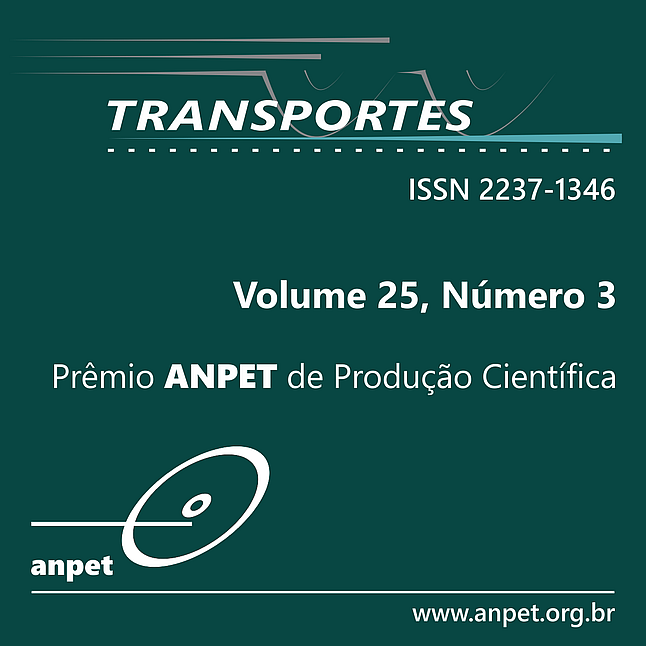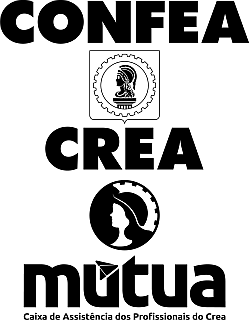Degradação do lastro ferroviário – principais aspectos e estudos de caso
DOI:
https://doi.org/10.14295/transportes.v25i3.1340Palavras-chave:
Lastro ferroviário, Degradação do lastro ferroviário, Superestrutura ferroviária.Resumo
A camada de lastro é considerada como um dos mais importantes elementos de um perfil estrutural ferroviário, exercendo um papel singular no comportamento mecânico deste. Devido ao tráfego e aos procedimentos de manutenção, ao longo do tempo, o lastro tende a se degradar. O objetivo deste artigo é avaliar a evolução da degradação do lastro por meio de parâmetros como granulometria, Coeficiente de Não Uniformidade (CNU), forma e seus distintos modos de degradação. Adicionalmente, apresenta-se uma visão geral referente à deterioração do lastro e, dentro deste contexto, dois estudos baseados em ensaios laboratoriais de degradação por abrasão, em conjunto com um procedimento que considera imagens dos grãos e o cisalhamento destes. De maneira geral, este artigo mostra diferentes modos de degradação e uma adequada representação qualitativa da evolução da degradação dos grãos através dos métodos utilizados baseados em ensaio de abrasão com obtenção de imagens e de cisalhamento.
Downloads
Referências
AAR (1989) Ballast Renewal Model User’s Manual, Report No R-701, Association of American Railroads, USA.
AREMA (2013) Manual for Railway Engineering, American Railway Engineering and Maintenance of Way Association, Vol. 1-4.
Aursudkij, B. (2007) A Laboratory Study of Railway Ballast Behavior under Traffic Loading and Tamping Maintenance, PhD. Thesis, University of Nottingham, UK, 234 p. ID: 10321.
Boler, H.; M. Wnek e E. Tutumluer (2012) “Establishing Linkages between Ballast Degradation and Imaging Based Aggregate Particle Shape, Texture and Angularity Indexes”, Advances in Transportation Geotechnics II, pp. 186-191.
Esveld, C. (1993) Uniform Ballast Quality Assessment Criteria, Rail Engineering International Edition, No 2, pp. 11-13. ISSN: 0141-4615
Fortunato, E. M. C. (2005) Renovação de Plataformas Ferroviárias – Estudos Relativos à Capacidade de Carga, PhD Thesis, University of Porto, 628 p. ID: 10216/11441
Indraratna, B e W. Salim (2003) Deformation and Degradation Mechanics of Recycled Ballast Stabilised with Geosynthetics, Soils and Foundations, Vol. 43, No 4, pp.35-46. DOI: 10.3208/sandf.43.4_35.
Indraratna, B.; J. Lackenby e D. Christie (2005) Effect of Confining Pressure on the Degradation of Ballast under Cyclic Loading, Géotechnique 55, No 4, pp. 325-328. DOI: 10.1680/geot.55.4.325.65490.
Indraratna, B.; P. K. Thakur e J. S. Vinod (2010) Experimental and Numerical Study of Railway Ballast Behaviour under Cyclic Loading, International Journal of Geomechanics, No 10, pp. 136-144. DOI : 10.1061/(ASGE)GM.1943-5622.0000055.
Indraratna, B.; W. Salim e C. Rujikiatkamjorn (2011) Advanced Rail Geotechnology – Ballasted Track, CRC press, 414 p. ISBN:9781138072893.
Ionescu, D. (2004) Evaluation of the Engineering Behaviour of Railway Ballast, PhD Thesis, University of Wollongong, Australia, 483 p.
Ionescu, D. (2005) Ballast Degradation and Measurement of Ballast Fouling, RTR 2, Eurailpress, pp. 12-18. ISBN: 0947644547.
Klincevicius, M. G. Y. (2011) Estudo de Propriedades, de Tensões e do Comportamento Mecânico de Lastros Ferroviários. Dissertação de Mestrado, Universidade de São Paulo, São Paulo, 171 p. DOI: 10.11606/D.3.2011.tde-27032012-121114
Lekarp, F.; U. Isacsson; e A. Dawson (2000) State of the art. I: Resilient Response of Unbound Aggregates, Journal of Transportation Engineering, Vol. 126, No 1, pp 66-75. DOI: 10.1061/(ASCE)0733-947X(2000)126:1(76).
Lichtberger, B. (2005) Track Compendium – Formation, Permanent Way, Maintenance, Economics, Eurail Press, 635 p. ISBN: 9783777103204
Lobo-Guerrero, S. e L. Vallejo (2005) Discrete Element Method Analysis of Railtrack Ballast Degradation During Cyclic Loading , Granular Matter No 8 (3), pp. 195-204. DOI: 10.1007/s10035-006-0006-2
Merheb, A. H. M. (2014) Análise Mecânica do Lastro Ferroviário por Meio de Ensaios Triaxiais Cíclicos. Dissertação de Mestrado, Universidade de São Paulo. São Paulo, p. 148. DOI: 10.11606/D.3.2014.tde-20052015-160602
Mvelase, G. M.; J. K. Boateng e P. J. Grabe (2012) Application of Laser Based Technology to Quantify Shape Properties of Railway Ballast, 31st Southern African Transp. Conf., pp. 243-254. ISBN: 978-1-920017-53-8
Neidhart, T. e G. Schulz. (2011) Dynamic Stability of Railway Tracks – Dystafit, an Innovation in Testing, GEORAIL – International Symposium Railway Geotechnical Engineering, France, pp. 335-346.
Nurmikolu, A. (2005) Degradation and Frost Susceptibility of Crushed Rock Aggregates Used in the Structural Layers of Railway Track, PhD Thesis, Tampere University of Technology, 325 p. ISBN: 952-15-1481-7.
Oda, M. e K. Iwashita (1999) Mechanics of Granular Materials: An Introduction, A. A. Balkema. ISBN: 9789054104612
Paderno, C. (2010) Ballast Behavior Under Action of Tamping and Railway Traffic, PhD Thesis, EPFL, Suíça, 186 p. DOI: 10.5075/epfl-thesis-4697
Perales, R.; G. Saussine; N. Milesi e Y. Descantes (2011) On the Damaging Effects of the Ballast Tamping Operation, 9th World Congress on Railway Research, 10 p.
Pires, J. J. e A. G. D. Dumont (2015) Railway Ballast Degradation, STRC – 15th Swiss Transport Research Conference, Ascona, 25p.
Raymond, G. P. e V. A. Diyaljee (1979) Railroad Ballast Load Ranking Classification, Journal of the Geotechnical Engineering, ASCE 105, No10, pp. 1133-1153. ISSN: 1090-0241
Raymond, G. P. (1985) Research on Railroad Ballast Specification and Evaluation, Transportation Research Board, pp. 1-6. ISBN: 0309038162.
Röthlisberger, F.; J. Cuénoud; L. Chastan; J. Däppen e E. Kuerzen (2006) Compressive Strength of Aggregates on the Stack, VSS 1993/012, 59 pages.
Ruth, B. E. e M. Tia (1998) Aggregate Degradation Testing by Gyratory Testing Machine. Transportation Research Record 1619, No 98-0062, 8 p. DOI: 10.3141/1619-01.
Selig, E. T. e D. L. Boucher (1990) Abrasion Tests for Railroad Ballasts, Geotechnical Testing Journal, Vol. 13, Issue 4, pp. 301-311. ISSN: 0149-6115.
Selig, E. T. e J. M. Waters (1994) Track Geotechnology and Substructure Management, Thomas Telford Services Ltd. DOI: 10.1680/tgasm.20139.fm
Sevi, A. S. (2008) Physical Modeling of Railroad Ballast using Parallel Gradation Scaling Technique within the Cyclical Triaxial Framework. PhD Thesis, Missouri University of Science and Technology, 137p.
SN 670-110/EN 13450 (2002) Granulats pour Ballasts de Voies Ferrées.
Terzagui, K e R. B. Peck (1962) Soil Mechanics, Ao livro técnico S.A., 659 p.
VALE (2011) Comunicação pessoal.
Wadel, A. D. (1932) Volume, Shape and Roundness of Quartz Particles, The Journal of Geology, Vol. 40, No 5, pp.443-451. DOI: 10.1086/624298.
Downloads
Publicado
Como Citar
Edição
Seção
Licença
Ao submeter um manuscrito para publicação neste periódico, todos os seus autores concordam, antecipada e irrestritamente, com os seguintes termos:
- Os autores mantém os direitos autorais e concedem à Transportes o direito de primeira publicação do manuscrito, sem nenhum ônus financeiro, e abrem mão de qualquer outra remuneração pela sua publicação pela ANPET.
- Ao ser publicado pela Transportes, o manuscrito fica automaticamente licenciado sob a Licença Creative Commons CC BY 4.0. Esta licença permite o seu compartilhamento com reconhecimento da autoria e da publicação inicial neste periódico.
- Os autores têm autorização para assumir contratos adicionais separadamente, para distribuição não exclusiva da versão do trabalho publicada neste periódico (por ex.: publicar em repositório institucional ou como capítulo de livro), com reconhecimento da publicação inicial na Transportes, desde que tal contrato não implique num endosso do conteúdo do manuscrito ou do novo veículo pela ANPET.
- Os autores têm permissão e são estimulados a publicar e distribuir seu manuscrito online (por ex.: em repositórios institucionais ou na sua página pessoal) depois de concluído o processo editorial. Como a Transportes é de acesso livre, os autores são estimulados a usar links para o DOI do artigo nesses casos.
- Os autores garantem ter obtido a devida autorização dos seus empregadores para a transferência dos direitos nos termos deste acordo, caso esses empregadores possuam algum direito autoral sobre o manuscrito. Além disso, os autores assumem toda e qualquer responsabilidade sobre possíveis infrações ao direito autoral desses empregadores, isentando a ANPET e a Transportes de toda e qualquer responsabilidade neste sentido.
- Os autores assumem toda responsabilidade sobre o conteúdo do manuscrito, incluindo as devidas e necessárias autorizações para divulgação de dados coletados e resultados obtidos, isentando a ANPET e a Transportes de toda e qualquer responsabilidade neste sentido.









